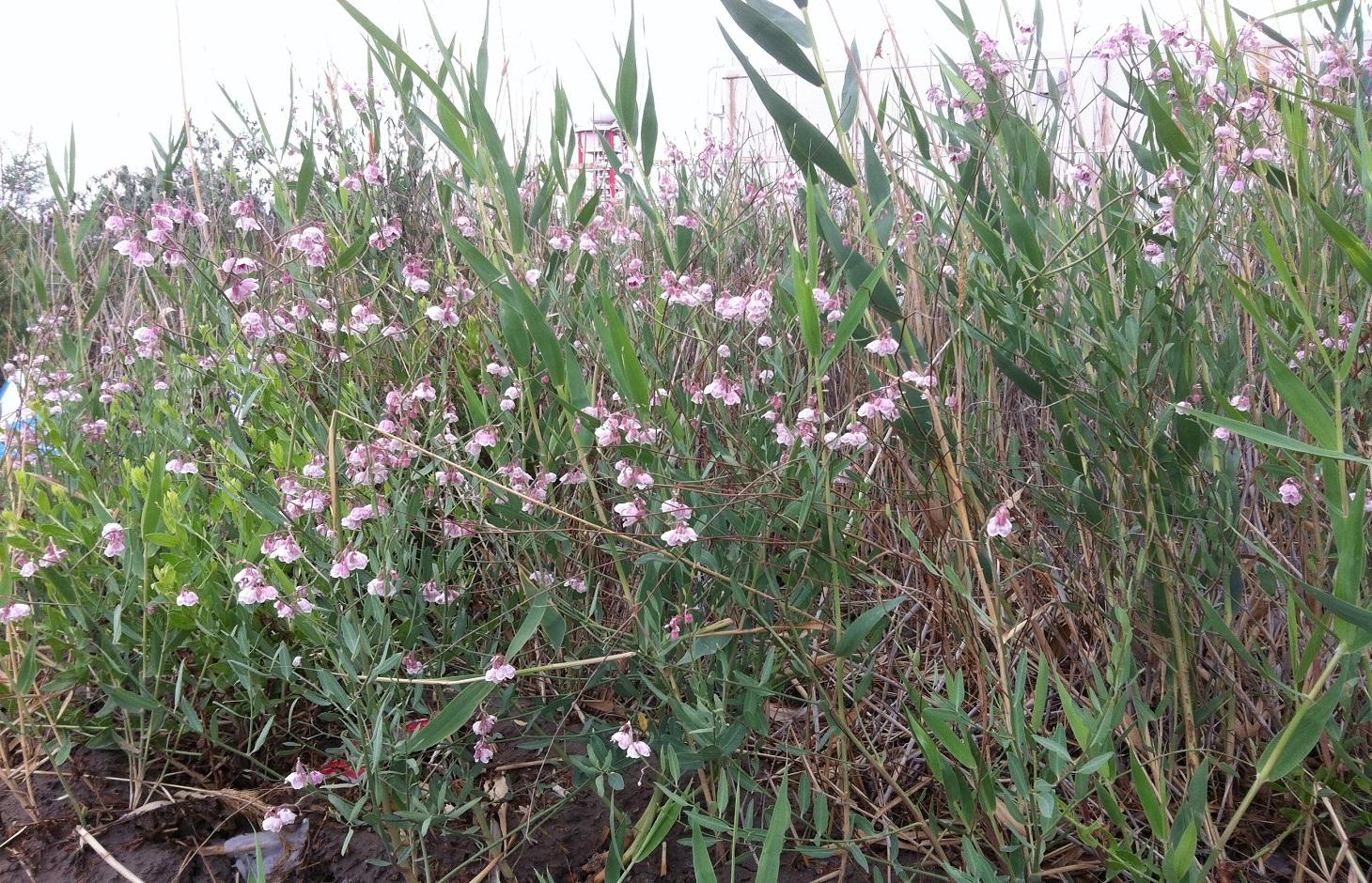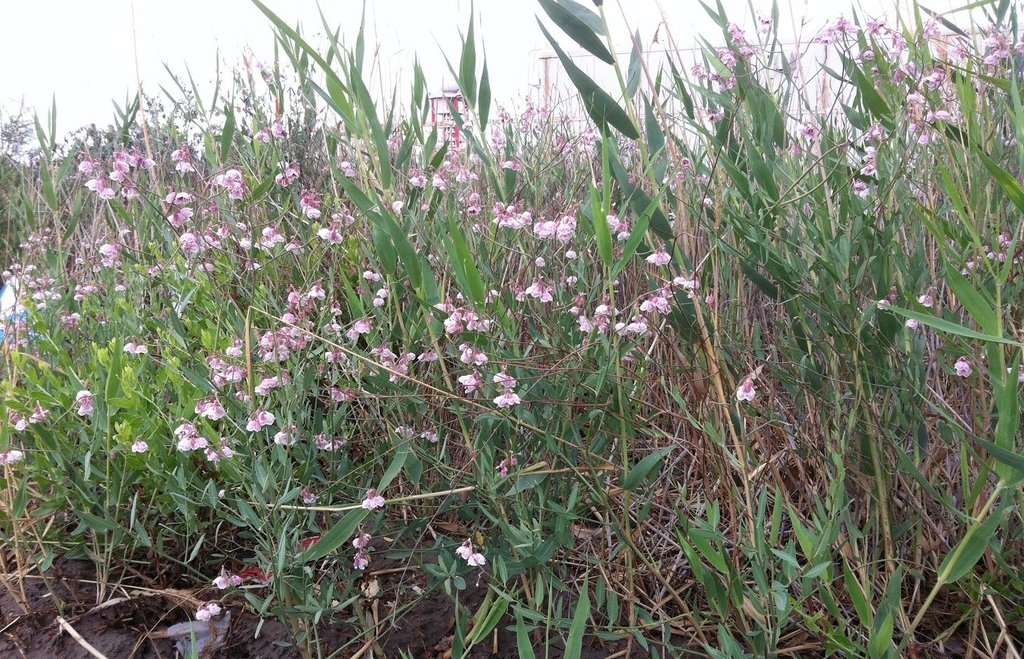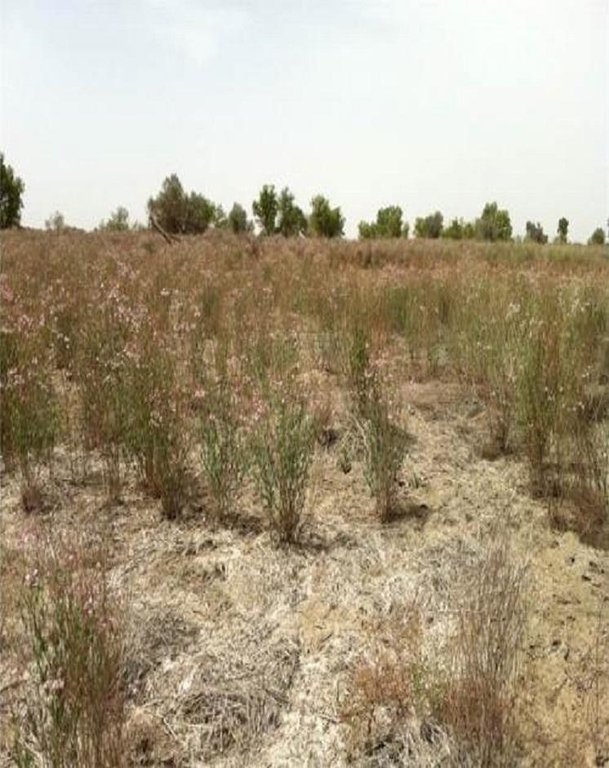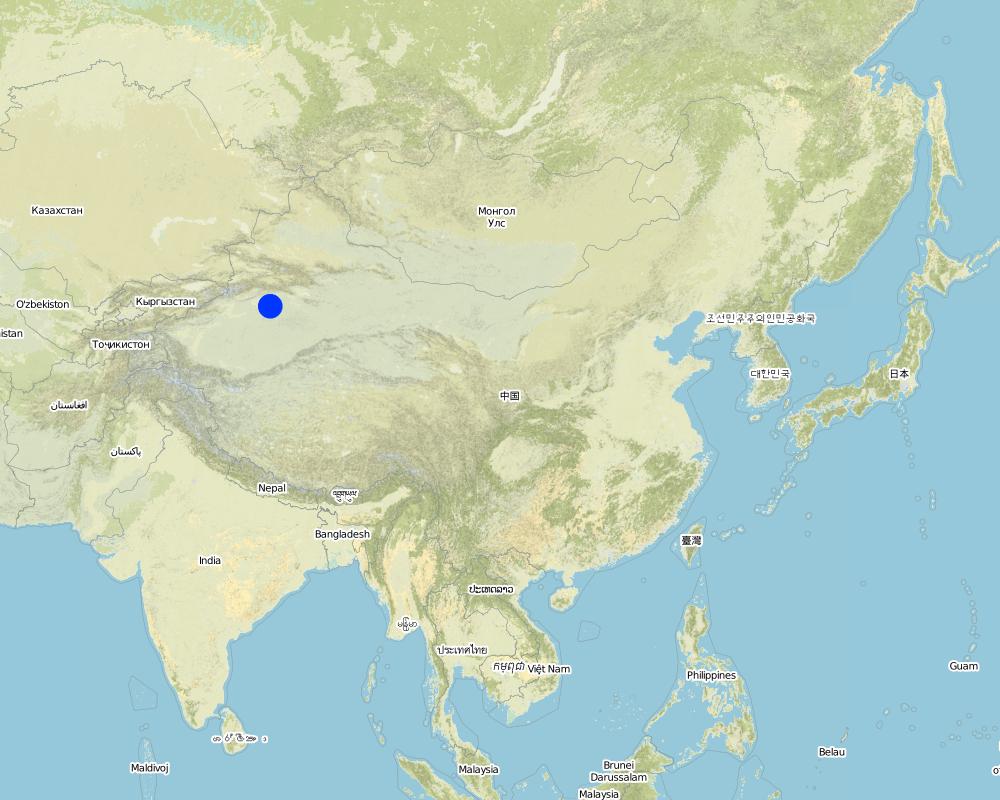Apocynum planting to protect and profit from saline soils in the Tarim River Basin, north-west China [الصين]
- تاريخ الإنشاء:
- تحديث:
- جامع المعلومات: Christian Rumbaur
- المحرر: –
- المراجعون: David Streiff, Deborah Niggli
罗布红麻 and 罗布百麻 (Chinese)
technologies_1721 - الصين
- Apocynum planting to protect and profit from saline soils in the Tarim River Basin, north-west China: 9 مارس، 2017 (inactive)
- Apocynum planting to protect and profit from saline soils in the Tarim River Basin, north-west China: 4 إبريل، 2018 (inactive)
- Apocynum planting to protect and profit from saline soils in the Tarim River Basin, north-west China: 19 مارس، 2019 (public)
عرض الأقسام
توسيع الكل طي الكل1. معلومات عامة
1.2 تفاصيل الاتصال بالأشخاص الرئيسيين لمصدر المعلومات والمؤسسات المشاركة في تقييم وتوثيق التقنية
متخصص في الإدارة المستدامة للأراضي:
Rouzi Ahmatjan
Catholic University Ingolstadt-Eichstaett
ألمانيا
متخصص في الإدارة المستدامة للأراضي:
Thevs Niels
N.Thevs@cgiar.org
World Agroforestry Center, University of Central Asia
قرغيزستان
اسم المشروع الذي سهّل توثيق/تقييم التقنية (إذا كان ذلك على صلة)
Sustainable Management of River Oases along the Tarim River, China (SuMaRiO / GLUES)اسم المشروع الذي سهّل توثيق/تقييم التقنية (إذا كان ذلك على صلة)
Book project: Making sense of research for sustainable land management (GLUES)اسم المؤسسة (المؤسسات) التي سهلت توثيق/تقييم التقنية (إذا كان ذلك على صلة)
Catholic University Ingolstadt-Eichstaett (KU) - ألمانيااسم المؤسسة (المؤسسات) التي سهلت توثيق/تقييم التقنية (إذا كان ذلك على صلة)
International Centre for Research in Agroforestry (ICRAF) - كينيا1.3 الشروط المتعلقة باستخدام البيانات الموثقة من خلال WOCAT
متى تم تجميع البيانات (ميدانيا)؟:
14/03/2014
يوافق جامع المعلومات والشخص (لاشخاص) الرئيسي لمصدر المعلومات على الشروط المتعلقة باستخدام البيانات الموثقة من خلال WOCAT:
نعم
2. وصف تقنيةالإدارة المستدامي للأراضي
2.1 وصف مختصر للتقنية
تعريف التقنية:
Plantation of Apocynum pictum and Apocynum venetum as protective and profitable indigenous plants - on soils made saline through irrigation of cotton without adequate drainage.
2.2 وصف تفصيلي للتقنية
الوصف:
The natural ecosystems in north-west China, especially in Xinjiang Province, are dominated by steppes, semi-deserts and desert. Riparian forests along the Tarim River Basin have been reduced and degraded by the expansion of irrigated agriculture since the 1950s. The main crop planted is cotton. In the arid temperate cold desert climate, precipitation is very low and evaporation high. The only water source for the region is the Tarim River. Xinjiang is being promoted to become the main cotton production area of China, especially in the upper reaches of the Tarim River, and reservoirs with a large irrigation infrastructure have been established. Farmers water their fields with flood and drip irrigation. But most of the fields have no drainage system. With the high evaporation and the capillary rise of the shallow groundwater, salts dissolved in the water accumulate on the soil surface and in the soil. This salinization makes the fields unusable for cotton production and are abandoned as farmers move on. These barren saline soils are prone to wind erosion, as almost no plants can grow on them. Large-scale desertification is the result.
Purpose of the Technology: To halt desertification the barren saline soils need to be protected by vegetation to avoid soil loss by wind. But if this can be done through vegetation that yields an income then the advantage is double: a win-win situation. Apocynum venetum and Apocynum pictum are indigenous and both are drought and salt tolerant. They are phreatophytes: deep-rooted plants that tap groundwater or the soil layer just above the water table. A.venetum and A. pictum are rhizomatous perennials – and importantly they are cash crops too. Fibre from the stems are used to produce textiles, though the extraction process is time and labor consuming. The advantage of apocynum yarn is that it has antibacterial properties. The leaves and flowers are also sold and used to produce tea which is a Traditional Chinese Medicine (TCM) that reduces blood pressure. On a per hectare basis, the stem generates a potential income of US$ 3,650, the leaves US$ 1,995, and the flowers US$ 1,815: nevertheless the market for apocynum products is small. In Xinjiang most of the apocynum plantations are under commercial large-scale farmers. They have the capital to deal with the costly establishment of apocynum.
Natural / human environment: Fields on which apocynum is sown should have a groundwater level not deeper than 2m. Nevertheless the soil should be well-drained: best is a sandy loam. Waterlogged, calcareous, clayey soils are not suitable. Apocynum can withstand periods of water inundation; however, prolonged submergence or waterlogging inhibits its growth. The topsoil under apocynum is often saline, reaching salt contents of up to 20%. Apocynum can grow on sites with a pronounced surface salinization, as long as the subsoil and the groundwater are not strongly salinized. There are two methods of planting apocynum: by seed or by vegetative means. While irrigation helps establishment and good yields, this is at a much lower level than for cotton. In conclusion, A.venetum and A. pictum provide profitable options on saline soils, grow with minimal irrigation, and protect the land against wind erosion.
2.3 صور التقنية
2.5 البلد/المنطقة/المواقع التي تم تنفيذ التقنية فيها والتي يغطيها هذا التقييم
البلد:
الصين
المنطقة/الولاية/المحافظة:
China / Xinjiang Province
مزيد من التفاصيل حول الموقع:
Tarim River Basin
التعليقات:
Boundary points of the Technology area: Location in China between 37°~46°N and 76°~104°E. Location in Tarim River Basin: 41°12'34.94"N and 84°19'28.19"E
Map
×2.6 تاريخ التنفيذ
في حالة عدم معرفة السنة بالتحديد، يرجى الإشارة إلى التاريخ التقريبي:
- منذ أكثر من 50 عامًا (تقليدي)
2.7 إدخال التقنية
- naturally
3. تصنيف تقنية الإدارة المستدامي للأراضي
3.1 الغرض الرئيسي ( الأغراض الرئيسية) للتقنية
- الحد من تدهور الأراضي ومنعه وعكسه
- خلق أثر اقتصادي مفيد
3.2 نوع (أنواع) استخدام الأراضي الحالية حيث يتم تطبيق التقنية

الأراضي الزراعية
- زراعة سنوية
- زراعة معمرة (غير خشبية)
المحاصيل الرئيسية (المحاصيل النقدية والغذائية):
major cash crop: cotton
major food crop: wheat
other: Apocynum

غير ذلك
حدد:
wastelands, deserts, glaciers, swamps, recreation areas, etc
التعليقات:
Major land use problems (compiler’s opinion): Salinization, desertification, mismanagement of cotton monoculture, inadequate drainage under irrigation, abandonment of degraded land.
Major land use problems (land users’ perception): Water scarcity, salinization, land use rights.
Future (final) land use (after implementation of SLM Technology): Cropland: Ct: Tree and shrub cropping
Constraints of wastelands / deserts / glaciers / swamps: salt crust on the top soil layer and high salt content in the soil
إذا تغير استخدام الأراضي بسبب التقنية، قم بالإشارة إلى استخدام الأرض قبل تنفيذ التقنية:
Cropland: Ca: Annual cropping
3.3 مزيد من المعلومات حول استخدام الأراضي
إمدادات المياه للأرض التي يتم تنفيذ التقنية عليها:
- مختلط بعلي-مروي
عدد مواسم الزراعة في السنة:
- 1
حدد:
Longest growing period in days: 220Longest growing period from month to month: March to October with irrigation
3.4 مجموعةالإدارة المستدامة للأراضي التي تنتمي إليها هذه التقنية
- مصد الريح/حزام حماية
- تحسين أصناف النباتات/سلالات الحيوانات
3.5 انتشار التقنية
حدد انتشار التقنية:
- منتشرة بالتساوي على مساحة
إذا كانت التقنية منتشرة بالتساوي على منطقة ما، فحدد المنطقة التقريبية المغطاة:
- > 10,000 كم2
التعليقات:
In China the area of Apocynum vegetation, natural or artificial, amounts to 1,330,000 ha. One third to half of this area is located in Xinjiang, ie approximately 600,000 ha
3.6 التدابير التقنية في مجال إلادارة المستدامة للأراضي

التدابير النباتية
- V1: غطاء من الأشجار والشجيرات

التدابير الإدارية
- M1: التغيير في نوع استخدام الأراضي
التعليقات:
Main measures: vegetative measures, management measures
Type of vegetative measures: aligned: -graded strips *<sup>3</sup>, scattered / dispersed
3.7 الأنواع الرئيسية من تدهور الأراضي التي تناولتها التقنية

تآكل التربة الناتج عن الرياح
- (Et): فقدان التربة السطحية

التدهور الكيميائي للتربة
- (Cs): التملح/ القلونة

التدهور البيولوجي
- (Bc): تناقص الغطاء النباتي
- (Bh): فقدان الموائل
- (Bq): انخفاض الكمية/الكتلة الحيوية
- (Bs): انخفاض جودة وتركيبة الأنواع/التنوع
التعليقات:
Main type of degradation addressed: Et: loss of topsoil, Cs: salinisation / alkalinisation, Bc: reduction of vegetation cover, Bh: loss of habitats, Bq: quantity / biomass decline, Bs: quality and species composition /diversity decline
Main causes of degradation: soil management (Most fields have no drainage -> Increase of groundwater -> salinisation of soils), crop management (annual, perennial, tree/shrub) (Cotton monocultures), wind storms / dust storms (Duststorms, blow ou tof topsoil), droughts (It is an arid climate), population pressure (doubling the population during the last thirty years), land tenure (land belongs to the state), education, access to knowledge and support services (poorer farmers have less access to extension services)
Secondary causes of degradation: discharges (point contamination of water) (Non-point source pollution and drainage water discharge from the fields), disturbance of water cycle (infiltration / runoff) (Most fields have no drainage -> Increase of groundwater -> salinisation of soils), floods (Floods are necessary for the region (riparian forests)), poverty / wealth (family farmers are poorer than city dwellers)
3.8 منع أو حد أو عكس تدهور الأراضي
تحديد هدف التقنية فيما يتعلق بتدهور الأراضي:
- اصلاح/إعادة تأهيل الأراضي المتدهورة بشدة
التعليقات:
Main goals: rehabilitation / reclamation of denuded land
4. المواصفات الفنية، وأنشطة التنفيذ، والمدخلات، والتكاليف
4.2 المواصفات الفنية/شروحات الرسم الفني
Apocynum planted in a levelled field with strips of 8 to 18 cm height and 30 to 40 cm width with 40 cm space between each strip
Technical knowledge required for field staff / advisors: moderate (for regeneration and multiplication)
Technical knowledge required for land users: moderate
Main technical functions: improvement of ground cover, stabilisation of soil (eg by tree roots against land slides), promotion of vegetation species and varieties (quality, eg palatable fodder)
Secondary technical functions: reduction in wind speed
Aligned: -graded strips
Vegetative material: C : perennial crops
Number of plants per (ha): 20,000
Vertical interval between rows / strips / blocks (m): 0
Vertical interval within rows / strips / blocks (m): 0.4
Width within rows / strips / blocks (m): 0.3 to 0.4
Scattered / dispersed
Vegetative material: C : perennial crops
Number of plants per (ha): 60,000 to 70,000
Vertical interval between rows / strips / blocks (m): 0.3
Spacing between rows / strips / blocks (m): 0.3
Vertical interval within rows / strips / blocks (m): 0.3
Width within rows / strips / blocks (m): 0.3
Gradient along the rows / strips: 0%
4.3 معلومات عامة بخصوص حساب المدخلات والتكاليف
حدد العملة المستخدمة لحساب التكاليف:
- دولار أمريكي
أشر إلى سعر الصرف من الدولار الأمريكي إلى العملة المحلية (إذا كان ذا صلة): 1 دولار أمريكي =:
-0,42
4.4 أنشطة التأسيس
| النشاط | نوع التدبير | التوقيت | |
|---|---|---|---|
| 1. | Manuring (3700 to 5000 kg/ha) and ploughing | نباتية | Before sowing |
| 2. | Site establishment/ preparation | نباتية | |
| 3. | Planting of seedlings/ root cuttings/ transplants | نباتية | most suitable seeding time is mid April to May or transplantation |
| 4. | Irrigation at establishment (10000-12000 m3/ha) | نباتية | After sowing |
4.5 التكاليف والمدخلات اللازمة للتأسيس
| تحديد المدخلات | الوحدة | الكمية | التكاليف لكل وحدة | إجمالي التكاليف لكل مدخل | % من التكاليف التي يتحملها مستخدمو الأراضي | |
|---|---|---|---|---|---|---|
| العمالة | Site establishment/ preparation | ha | 2,0 | 18,7 | 37,4 | 100,0 |
| المواد النباتية | Seeds | ha | 100,0 | 2,5 | 250,0 | |
| المواد النباتية | Seedlings | ha | 100,0 | 6,18 | 618,0 | |
| غير ذلك | Manure | ha | 171,1 | 18,7 | 3199,57 | 100,0 |
| غير ذلك | Waterfee | - | 1,0 | 460,0 | 460,0 | 100,0 |
| إجمالي تكاليف إنشاء التقنية | 4564,97 | |||||
التعليقات:
Duration of establishment phase: 15 month(s)
4.6 الصيانة/الأنشطة المتكررة
| النشاط | نوع التدبير | التوقيت/الوتيرة | |
|---|---|---|---|
| 1. | irrigation and weeding labor | نباتية | 6 times |
| 2. | Fertilizer | نباتية | |
| 3. | Harvest labor | نباتية | at harvest |
| 4. | Transport | نباتية | after harvest |
4.7 التكاليف والمدخلات اللازمة للصيانة/للأنشطة المتكررة (سنويًا)
| تحديد المدخلات | الوحدة | الكمية | التكاليف لكل وحدة | إجمالي التكاليف لكل مدخل | % من التكاليف التي يتحملها مستخدمو الأراضي | |
|---|---|---|---|---|---|---|
| العمالة | irrigation and weeding labor | ha | 10,0 | 114,0 | 1140,0 | 100,0 |
| العمالة | Harvest labor | ha | 1,0 | 359,0 | 359,0 | 100,0 |
| معدات | Transport | ton | 1,0 | 11,0 | 11,0 | 100,0 |
| الأسمدة والمبيدات الحيوية | Fertilizer (Phosporus) | kg | 150,0 | 4,12 | 618,0 | |
| غير ذلك | Waterfee | 1,0 | 2280,0 | 2280,0 | ||
| إجمالي تكاليف صيانة التقنية | 4408,0 | |||||
التعليقات:
Machinery/ tools: hoe, shovel, tractor and plough
Costs were calculated for 2015, per hectare. Labour has become more expensive over the last few years. In the beginning (first two years) cultivation of apocynum is very labour and input intensive. After 1.5 to 2 years the plants can be harvested for the first time. The price for the products of apocynum (leafs and stems) are very high. Direct seeding as compared to vegetative propagation is the most labour-saving method to cultivate apocynum.
5. البيئة الطبيعية والبشرية
5.1 المناخ
هطول الأمطار السنوي
- < 250 مم
- 251- 500 ملم
- 501 - 750ملم
- 1,000-751 ملم
- 1,500-1,100 ملم
- 2,000-1,500 ملم
- 3,000-2,001 ملم
- 4,000-3,100 ملم
- > 4000 ملم
المواصفات/التعليقات على هطول الأمطار:
Per year: 90 mm; Jan, Feb, Apr, May: 3 mm; Mar, Sept: 5mm; Jun: 33 mm; Jul: 18 mm; Oct: 0 mm; Dec: 8 mm
المنطقة المناخية الزراعية
- قاحلة
Thermal climate class: temperate. cold desert climate
5.2 طوبوغرافيا
متوسط الانحدارات:
- مسطح (0-2%)
- بسيط (3-5%)
- معتدل (6-10%)
- متدحرج (11-15%)
- تلال (16-30%)
- شديدة الانحدار(31-60%)
- فائقة الانحدار (>60%)
التضاريس:
- هضاب/سهول
- أثلام مرتفعة
- المنحدرات الجبلية
- منحدرات التلال
- منحدرات في السفوح
- قاع الوادي
المنطقة الارتفاعية:
- 100-0 متر فوق سطح البحر
- 500-101 متر فوق سطح البحر
- 1,000-501 متر فوق سطح البحر
- 1,500-1,001 متر فوق سطح البحر
- 2,000-1,501 متر فوق سطح البحر
- 2,500-2,100 متر فوق سطح البحر
- 3,000-2,501 متر فوق سطح البحر
- 4,000-3,001 متر فوق سطح البحر
- > 4000 متر فوق سطح البحر
وضح ما إذا كانت التقنية مطبقة على وجه التحديد في:
- غير ذات صلة
التعليقات والمواصفات الإضافية بشأن التضاريس:
Altitudinal zone: Altitude between 800 and 1300 m
5.3 التربة
متوسط عمق التربة:
- ضحل جدًا (0-20 سم)
- ضحلة (21-50 سم)
- متوسطة العمق (51-80 سم)
- عميقة (81-120 سم)
- عميقة جدًا (> 120 سم)
قوام التربة (التربة السطحية):
- خشن / خفيف (رملي)
- متوسط ( طميي، سلتي)
المواد العضوية في التربة السطحية:
- منخفضة (<1%)
إذا كان متاحًا، قم بإرفاق وصف كامل للتربة أو تحديد المعلومات المتوفرة، على سبيل المثال نوع التربة، الرقم الهيدروجيني/ درجة حموضة التربة، قدرة التبادل الكاتيوني، النيتروجين، الملوحة وما إلى ذلك.
Soil fertility: low - medium
Soil drainage / infiltration: medium
Soil water storage capacity: medium - high
5.4 توافر المياه ونوعيتها
منسوب المياه الجوفية:
50-5 م
توافر المياه السطحية:
جيد
نوعية المياه (غير المعالجة):
مياه الشرب سيئة (تتطلب معالجة)
تعليقات ومواصفات أخرى بشأن نوعية المياه وكميتها:
Ground water table also < 5 m: Apocynum is a phreatophyte. The most productive sites of Apocynum venetum are found on a groundwater not deeper than 3 m with salt contets between 1g/l and 10g/l.
Ground water table 5-50 m: Apocynum pictum is mainly found on groundwater levels of 4-6m below surface with a maximum groundwater depth of 8 m. Apocynum is restricted to groundwater levels not deeper than 4 m below surface.
5.5 التنوع البيولوجي
تنوع الأنواع:
- متوسط
5.6 خصائص مستخدمي الأراضي الذين يطبقون التقنية
التوجه السوقي لنظام الإنتاج:
- تجاري/سوق
الدخل من خارج المزرعة:
- أقل من % 10من كامل الدخل
المستوى النسبي للثروة:
- ثري
- ثري جدا
أفراداً أو مجموعات:
- المجموعات/ المجتمع المحلي
مستوى المكننة:
- عمل يدوي
- ميكانيكية/ مزودة بمحرك
الجنس:
- رجال
اذكر الخصائص الأخرى ذات الصلة لمستخدمي الأراضي:
Land users applying the Technology are mainly common / average land users
Difference in the involvement of women and men: Man are doing the hard work in the fields, women do more the harvesting
Population density: 10-50 persons/km2
Annual population growth: > 4%; 7%
5% of the land users are very rich and own 10% of the land.
20% of the land users are rich and own 30% of the land.
40% of the land users are average wealthy and own 30% of the land.
30% of the land users are poor and own 20% of the land.
5% of the land users are poor and own 10% of the land.
Off-farm income specification: The plantation of Apocynum brings a high income to the farmers.
Level of mechanization manual labour: harvesting
Market orientation of production system commercial/ market: Apocynum is planted for fibre, tea and medicinal products
Level of mechanization mechanized/motorized: field preparation
5.7 متوسط مساحة الأرض المملوكة أو المستأجرة من قبل مستخدمي الأراضي الذين يطبقون التقنية
- < 0.5 هكتارا
- 0.5 - 1 هكتار
- 1 -2 هكتار
- 2 - 5 هكتار
- 5 - 15 هكتار
- 15 - 50 هكتار
- 50 - 100هكتار
- 500-100 هكتار
- 1,000-500 هكتار
- 10,000-1,000 هكتار
- > 10,000 هكتار
هل يعتبر هذا نطاقًا صغيرًا أو متوسطًا أو واسعا (في إشارة إلى السياق المحلي)؟:
- على نطاق متوسط
التعليقات:
< 0.5 ha: family farms
5-15 ha: state farms
5.8 ملكية الأراضي، وحقوق استخدام الأراضي، وحقوق استخدام المياه
ملكية الارض:
- دولة
حقوق استخدام الأراضي:
- مجتمعي (منظم)
- مؤجر
حقوق استخدام المياه:
- مجتمعي (منظم)
- مؤجر
التعليقات:
All the land belongs to the state. Farmers have the right to use the land for 70 years.
5.9 الوصول إلى الخدمات والبنية التحتية
الصحة:
- ضعيف
- معتدل
- جيد
التعليم:
- ضعيف
- معتدل
- جيد
المساعدة التقنية:
- ضعيف
- معتدل
- جيد
العمل (على سبيل المثال خارج المزرعة):
- ضعيف
- معتدل
- جيد
الأسواق:
- ضعيف
- معتدل
- جيد
الطاقة:
- ضعيف
- معتدل
- جيد
الطرق والنقل:
- ضعيف
- معتدل
- جيد
مياه الشرب وخدمات الصرف الصحي:
- ضعيف
- معتدل
- جيد
الخدمات المالية:
- ضعيف
- معتدل
- جيد
6. الآثار والتصريحات الختامية
6.1 الآثار التي أظهرتها التقنية في الموقع
الآثار الاجتماعية والاقتصادية
الإنتاج
إنتاج المحاصيل
إنتاج الخشب
خطر فشل الإنتاج
تنوع المنتج
منطقة الإنتاج
توافر المياه ونوعيتها
الطلب على مياه الري
الدخل والتكاليف
النفقات على المدخلات الزراعية
دخل المزرعة
تنوع مصادر الدخل
عبء العمل
آثار اجتماعية واقتصادية أخرى
market for apocynum fibre
market for TCM
الآثار الاجتماعية والثقافية
الفرص الثقافية
الفرص الترفيهية
التخفيف من حدة الصراع
Livelihoods and human well-being
الآثار الايكولوجية
دورة المياه / الجريان السطحي
كمية المياه
جودة المياه
تصريف المياه الزائدة
التربة
رطوبة التربة
غطاء التربة
فقدان التربة
تكون قشرة التربة السطحية/انسداد مسام التربة
المادة العضوية في التربة/تحت الطبقة c
التنوع البيولوجي: الغطاء النباتي، الحيوانات
الكتلة الحيوية/ طبقة الكربون فوق التربة
التنوع النباتي
تنوع الموائل
الحد من مخاطر المناخ والكوارث
سرعة الرياح
6.2 الآثار التي أظهرتها التقنية خارج الموقع
تلوث المياه الجوفية/الأنهار
الرواسب المنقولة بواسطة الرياح
6.3 تعرض التقنية وحساسيتها لتغير المناخ التدريجي والظواهر المتطرفة/الكوارث المرتبطة بالمناخ (كما يراها مستخدمو الأراضي)
تغير مناخ تدريجي
تغير مناخ تدريجي
| الموسم | نوع التغير المناخي/ المتطرف | كيف تتعامل التقنية مع ذلك؟ | |
|---|---|---|---|
| درجة الحرارة السنوية | زيادة | غير معروف |
الظواهر المتطرفة / الكوارث المرتبطة بالمناخ
الكوارث الجوية
| كيف تتعامل التقنية مع ذلك؟ | |
|---|---|
| عاصفة ممطرة محلية | جيدا |
| عاصفة هوائية محلية | جيدا |
الكوارث المناخية
| كيف تتعامل التقنية مع ذلك؟ | |
|---|---|
| جفاف | جيدا |
الكوارث الهيدرولوجية
| كيف تتعامل التقنية مع ذلك؟ | |
|---|---|
| فيضان عام (نهر) | ليس جيدا |
العواقب الأخرى المتعلقة بالمناخ
العواقب الأخرى المتعلقة بالمناخ
| كيف تتعامل التقنية مع ذلك؟ | |
|---|---|
| انخفاض فترة النمو | غير معروف |
6.4 تحليل التكلفة والعائد
كيف يمكن مقارنة العوائد نسبة لتكاليف الإنشاء (من وجهة نظر مستخدمي الأراضي)؟
عوائد قصيرة الأجل:
سلبي
عوائد طويلة الأجل:
ايجابي جدا
كيف تتم مقارنة العوائدمع كلفة الصيانة/التكاليف المتكررة (من وجهة نظر مستخدمي الأراضي)؟
عوائد قصيرة الأجل:
سلبي قليلا
عوائد طويلة الأجل:
ايجابي جدا
التعليقات:
In the beginning (first two years) the plantation of Apocynum is very labour and input intensive. After 1.5 to 2 yearsthe plants can be harvested for the first time. The price for the producst of Apocynum (leafs and stems) are very high.
6.5 اعتماد التقنية
إذا كان متاحًا، قم بتحديد الكمية (عدد الأسر المعيشية و/أو المساحةالمغطاة):
No number on households
من بين جميع الذين تبنوا التقنية، كم عدد الذين فعلوا ذلك بشكل تلقائي، أي دون تلقي أي حوافز مادية/مدفوعات؟:
- 100-90%
التعليقات:
100% of land user families have adopted the Technology without any external material support
Comments on spontaneous adoption: Most of the plantations are planted by large investing farmers. The farmers sell the products of Apocynum to the pharmaceutical companies for Traditional Chinese Medicine (TCM)
There is a little trend towards spontaneous adoption of the Technology
6.7 نقاط القوة / المزايا / الفرص التي توفرها التقنية
| نقاط القوة/ المزايا/ الفرص من وجهة نظر جامع المعلومات أو غيره من الاشخاص الرئيسيين لمصدر المعلومات |
|---|
|
Both species yield fibres and leaves for fiber production and the leaves for medicinal products or tea on considerable areas under the arid climate of Xinjiang Province, China, without intensive irrigation, because they use the groundwater as for example cotton. Furthermore, both species can withstand higher soil salinization levels than cotton. How can they be sustained / enhanced? The plantations can be enhanced by analyzing the water consumption and the water use efficiency to apply only as much water to the plants as they need Not decreasing the yields. |
|
Both species can provide an income to local people - fibre and leaves for medicinal products or tea - under conditions which are unfavorable to grow crops under irrigation. How can they be sustained / enhanced? Promote apocynum on saline wastelands and subsidize the establishment of the plantations. Explore further markets and promote the products. |
|
Through apocynum plantations wastelands are reclaimed. How can they be sustained / enhanced? Highlight the potential to reduce wind erosion and ‘dust bowls’. |
6.8 نقاط ضعف / مساوىء / مخاطر التقنية وسبل التغلب عليها
| نقاط الضعف/ المساوىء/ المخاطر من وجهة نظر جامع المعلومات أو غيره من الاشخاص الرئيسيين لمصدر المعلومات | كيف يمكن التغلب عليها؟ |
|---|---|
| Difficult process to extract fibre from the stems. | New technology needs to be developed. |
| Small market. | New uses need to be explored to expand the market. |
| High investment in the beginning of the plantation. | Planting of apocynum should be subsidized. |
7. المراجع والروابط
7.2 المراجع للمنشورات المتاحة
العنوان، المؤلف، السنة، النظام القياسي الدولي لترقيم الكتب ISBN:
N Thevs et al. (2012) Apocynum venetum L. and Apocynum pictum Schrenk (Apocynaceae) as multi-functional and multi-service plant species in Central Asia: a review on biology, ecology, and utilization.
متاح من أين؟كم التكلفة؟:
Journal of Applied Botany and Food Quality 85, 159-167.
الروابط والوحدات المواضيعية
توسيع الكل طي الكلالروابط
لا يوجد روابط
الوحدات المواضيعية
لا يوجد وحدات مواضيعية





